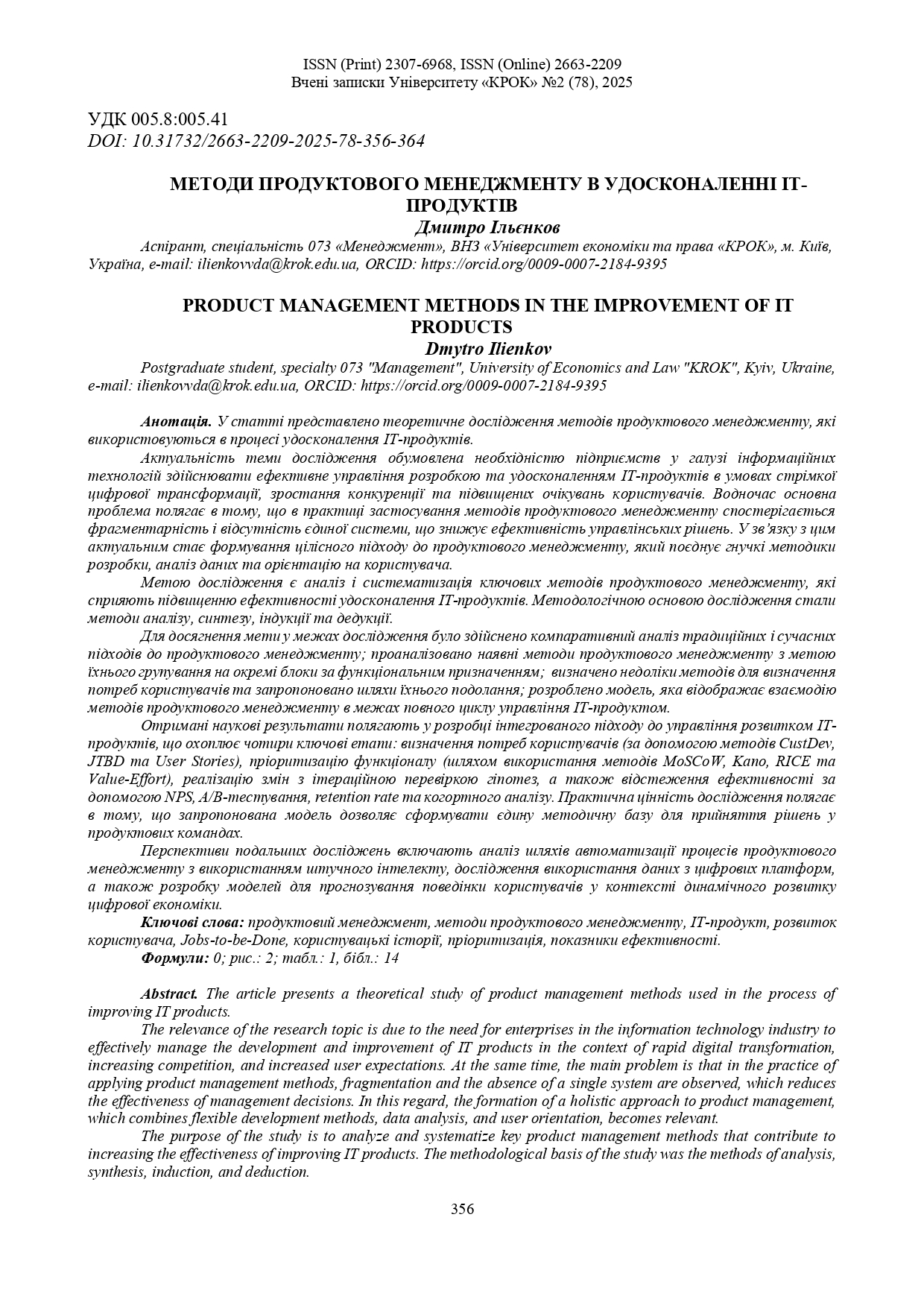PRODUCT MANAGEMENT METHODS IN THE IMPROVEMENT OF IT PRODUCTS
DOI:
https://doi.org/10.31732/2663-2209-2025-78-356-364Keywords:
product management, product management methods, IT product, Customer Development, Jobs-to-be-Done, User Stories, prioritization, performance indicatorsAbstract
The article presents a theoretical study of product management methods used in the process of improving IT products.
The relevance of the research topic is due to the need for enterprises in the information technology industry to effectively manage the development and improvement of IT products in the context of rapid digital transformation, increasing competition, and increased user expectations. At the same time, the main problem is that in the practice of applying product management methods, fragmentation and the absence of a single system are observed, which reduces the effectiveness of management decisions. In this regard, the formation of a holistic approach to product management, which combines flexible development methods, data analysis, and user orientation, becomes relevant.
The purpose of the study is to analyze and systematize key product management methods that contribute to increasing the effectiveness of improving IT products. The methodological basis of the study was the methods of analysis, synthesis, induction, and deduction.
To achieve the goal, a comparative analysis of traditional and modern approaches to product management was carried out within the framework of the study; existing product management methods were analyzed in order to group them into separate blocks according to functional purpose; identified shortcomings of methods for determining user needs and proposed ways to overcome them; developed a model that reflects the interaction of product management methods within the full IT product management cycle.
The obtained scientific results consist in the development of an integrated approach to managing the development of IT products, which includes four key stages: determining user needs (using the CustDev, JTBD and User Stories methods), prioritizing functionality (using the MoSCoW, Kano, RICE and Value-Effort methods), implementing changes with iterative hypothesis testing, as well as tracking effectiveness using NPS, A/B testing, retention rate and cohort analysis. The practical value of the study is that the proposed model allows for the formation of a single methodological basis for decision-making in product teams.
Prospects for further research include analyzing ways to automate product management processes using artificial intelligence, studying the use of data from digital platforms, and developing models to predict user behavior in the context of the dynamic development of the digital economy.
Downloads
References
Ang, L., & Buttle, F. (2009). Customer development strategies for exceeding expectations: An exploratory study. Journal of Database Marketing & Customer Strategy Management, 16(4), 257–266. https://doi.org/10.1057/dbm.2009.30
Chahal, S. (2023). Agile Methodologies for Improved Product Management. Journal of Business and Strategic Management, 8(4), 79–94. DOI: https://doi.org/10.47941/jbsm.1439
Clark, H. (2024). What is Value vs Effort Matrix and how does it work in product management? The Product Manager. https://theproductmanager.com/topics/value-vs-effort-matrix/
González, C. D. V. (2024). What is product management? Everything you need to know. Product School. https://productschool.com/blog/product-fundamentals/what-is-product-management
Henriksen, A. (2016). Agile project management. A case study on agile practices. Master’s Thesis in Business Administration . School of Business and Economics. Tromsø. P. 14. http://dx.doi.org/10.13140/RG.2.2.14048.33283
Karapetyan, S. (2024) How To Use Jobs To Be Done Framework: A Guide For Product Managers. TheProductManager. URL: https://theproductmanager.com/topics/how-to-use-jobs-to-be-done-framework-a-guide-for-product-managers/
Lucassen, G., Dalpiaz, F., Van Der Werf, J. M. E. M., & Brinkkemper, S. (2016). The use and effectiveness of user stories in practice. In R. Wieringa & A. Persson (Eds.), Requirements Engineering: Foundation for Software Quality (REFSQ 2016) (pp. 205–222). Springer. https://doi.org/10.1007/978-3-319-30282-9_14
Lucassen, G., Van de Keuken, M., Dalpiaz, F., Brinkkemper, S., Sloof, G. W., & Schlingmann, J. (2018). Jobs-to-be-done oriented requirements engineering: A method for defining job stories. In M. C. Jaeger & C. Horkoff (Eds.), Requirements Engineering: Foundation for Software Quality (REFSQ 2018) (pp. 227–243). Springer. https://doi.org/10.1007/978-3-319-77243-1_14
Maassen, M.A. (2018) Product development models in the IT sector-From Waterfall to Agile Project Management Model s in the case of AVIRA SOFT S.R.L. Proceedings of 2018 International Conference on Business Excellence. №12(1). Р. 568–578. DOI: https://doi.org/10.2478/picbe-2018-0051
ProductPlan. (n.d.). What is the RICE scoring model for prioritization? https://www.productplan.com/glossary/rice-scoring-model/
Qualtrics. (n.d.). Kano analysis: The Kano model explained. Qualtrics. https://www.qualtrics.com/experience-management/research/kano-analysis/
Suchetha, V., Krishna, P. K., Raviraja, H. M. (2024). Assessing the Effectiveness of MoSCoW Prioritization in Software Development: A Holistic Analysis across Methodologies. EAI Endorsed Transactions on Internet of Things, 10. http://dx.doi.org/10.4108/eetiot.6515
Кіндрат, О., & Дутка, Г. (2021). Agile-методи для ефективної та продуктивної імплементації ІТ-продукту. Наукові записки Львівського університету бізнесу та права. №28. С. 149–157. URL: https://nzlubp.org.ua/index.php/journal/article/view/400/377
Колянко, О., & Озимок, Г. (2017). Використання жорсткої «Waterfall» та гнучкої «Agile» моделей управління проектами. Економічний аналіз. №52. С. 177–182. URL: http://nbuv.gov.ua/UJRN/Vlca_ekon_2017_52_33

Downloads
Published
How to Cite
Issue
Section
License

This work is licensed under a Creative Commons Attribution-NonCommercial 4.0 International License.

